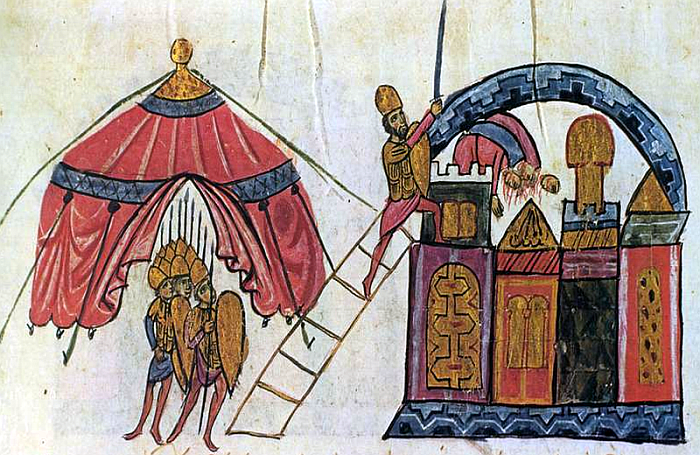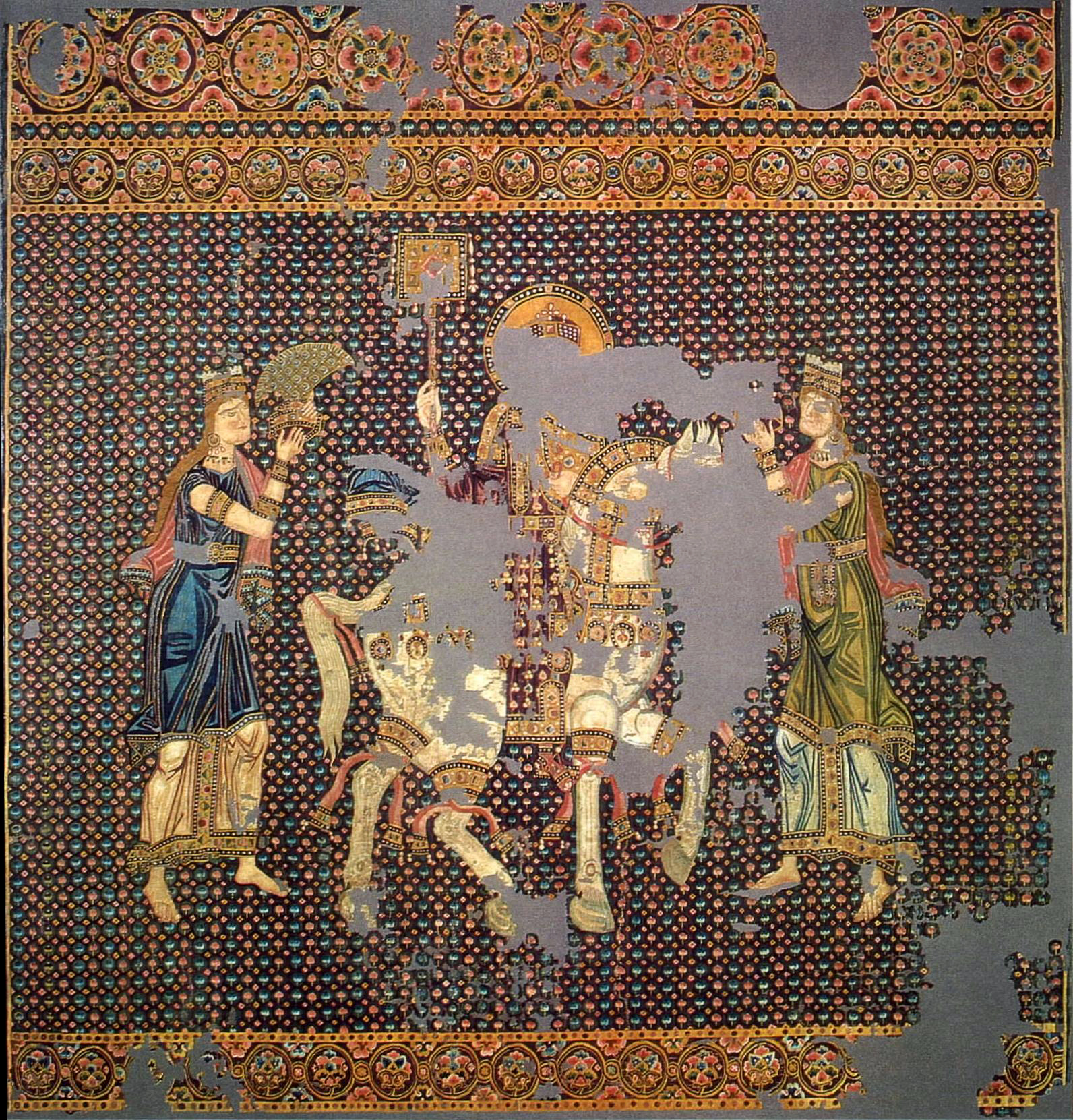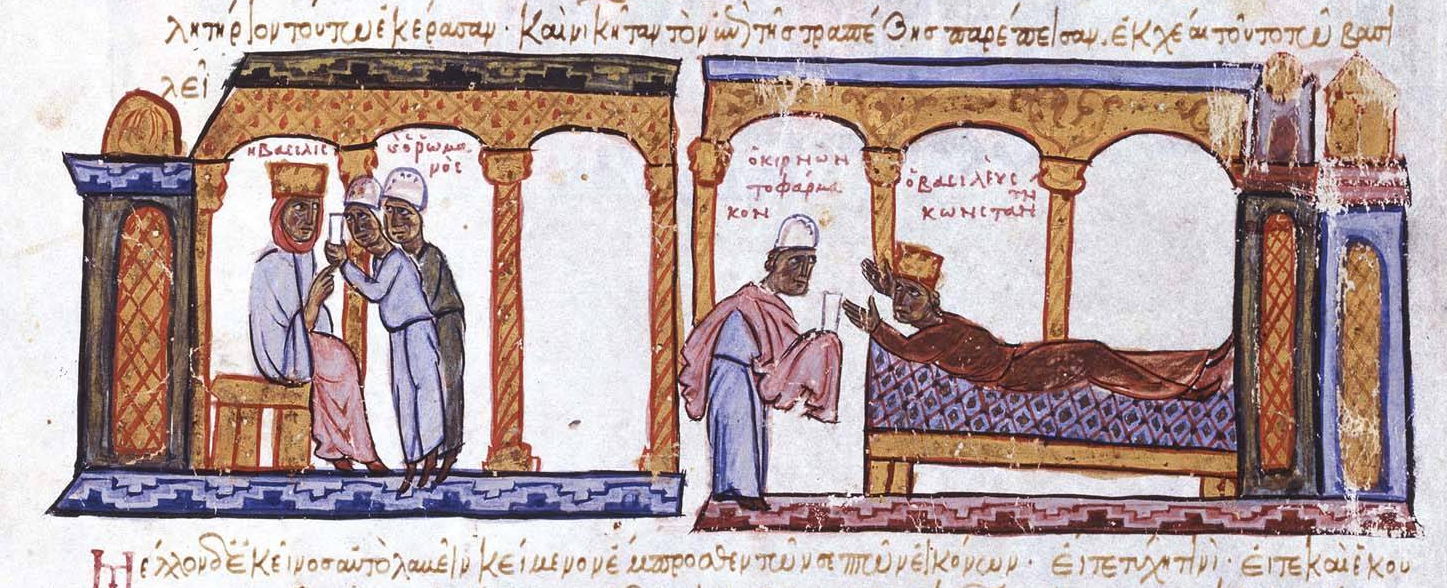|
969
Year 969 ( CMLXIX) was a common year starting on Friday (link will display the full calendar) of the Julian calendar, the 969th year of the Common Era (CE) and ''Anno Domini'' (AD) designations, the 969th year of the 1st millennium, the 69th year of the 10th century, and the 10th and last year of the 960s decade. Events By place Byzantine Empire * October 28 – Siege of Antioch: Byzantine general Michael Bourtzes (during a night attack) seizes part of Antioch's fortifications. The capture of the city from the Hamdanids is completed three days later, when reinforcements under the ''stratopedarches'' Peter Phokas arrive. The Byzantine army then moves deeper into Syrian territory — besieging and taking the city of Aleppo. * December 11 – Emperor Nikephoros II is murdered in the royal palace of Boukoleon at Constantinople after a 6-year reign. Former friends have acted on the instructions of his wife Theophano. Nikephoros is succeeded by his nephew John I T ... [...More Info...] [...Related Items...] OR: [Wikipedia] [Google] [Baidu] |
Nikephoros II Phokas
Nikephoros II Phokas (; – 11 December 969), Latinized Nicephorus II Phocas, was Byzantine emperor from 963 to 969. His career, not uniformly successful in matters of statecraft or of war, nonetheless included brilliant military exploits which contributed to the resurgence of the Byzantine Empire during the 10th century. In the east, Nikephoros completed the conquest of Cilicia and even retook the islands of Crete and Cyprus, thus opening the path for subsequent Byzantine incursions reaching as far as Upper Mesopotamia and the Levant; these campaigns earned him the sobriquet "pale death of the Saracens". Meanwhile in the west, he inflamed conflict with the Bulgarians and saw Sicily completely turn over to the Muslims, while he failed to make any serious gains in Italy following the incursions of Otto I. At home, Nikephoros' administrative policies caused controversy. He financed his wars with increased taxes both on the people and on the church, while maintaining unpopular th ... [...More Info...] [...Related Items...] OR: [Wikipedia] [Google] [Baidu] |
Byzantine Empire
The Byzantine Empire, also referred to as the Eastern Roman Empire or Byzantium, was the continuation of the Roman Empire primarily in its eastern provinces during Late Antiquity and the Middle Ages, when its capital city was Constantinople. It survived the fragmentation and fall of the Western Roman Empire in the 5th century AD and continued to exist for an additional thousand years until the fall of Constantinople to the Ottoman Empire in 1453. During most of its existence, the empire remained the most powerful economic, cultural, and military force in Europe. The terms "Byzantine Empire" and "Eastern Roman Empire" were coined after the end of the realm; its citizens continued to refer to their empire as the Roman Empire, and to themselves as Romans—a term which Greeks continued to use for themselves into Ottoman times. Although the Roman state continued and its traditions were maintained, modern historians prefer to differentiate the Byzantine Empire from Ancient Rome ... [...More Info...] [...Related Items...] OR: [Wikipedia] [Google] [Baidu] |
Michael Bourtzes
Michael Bourtzes ( el, Μιχαήλ Βούρτζης, Arabic: ''Miḥā’īl al-Burdjī''; ca. 930/35 – after 996) was a leading Byzantine general of the latter 10th century. He became notable for his capture of Antioch from the Arabs in 969, but fell into disgrace by the Emperor Nikephoros II Phokas. Resentful at the slight, Bourtzes joined forces with the conspirators who assassinated Phokas a few weeks later. Bourtzes re-appears in a prominent role in the civil war between Emperor Basil II and the rebel Bardas Skleros, switching his allegiance from the emperor to the rebel and back again. Nevertheless, he was re-appointed as '' doux'' of Antioch by Basil II, a post he held until 995, when he was relieved because of his failures in the war against the Fatimids. Biography Career under Nikephoros II and John Tzimiskes Michael Bourtzes was the first prominent member of the Bourtzes family, originating in the upper Euphrates region, which went on to become one of the major cl ... [...More Info...] [...Related Items...] OR: [Wikipedia] [Google] [Baidu] |
Peter I Of Bulgaria
Peter I ( cu, Петръ А҃; bg, Петър I) (died 30 January 970) was emperor (tsar) of Bulgaria from 27 May 927 to 969. His seal reads ΙΠSVΟς·GRECIA·VΟΔΟ. Early reign Peter I was the son of Simeon I of Bulgaria by his second marriage to the sister of George Sursuvul. Peter had been born early in the 10th century, but it appears that his maternal uncle was very influential at the beginning of his reign. In 913 Peter may have visited the imperial palace at Constantinople together with his older brother Michael. For unspecified reasons, Simeon had forced Michael to become a monk and had named Peter as his successor. To prove himself a worthy successor to his father both at home and in the eyes of foreign governments, Peter began his reign with a military offensive into Byzantine Thrace in 927 which was the last campaign of the Byzantine–Bulgarian war of 913–927. Nevertheless, he followed up his quick successes by secretly negotiating a peace treaty before the ... [...More Info...] [...Related Items...] OR: [Wikipedia] [Google] [Baidu] |
Siege Of Antioch (968–969)
The siege of Antioch (968–969) was a successful military offensive undertaken by leading commanders of the Byzantine Empire in order to reconquer the strategically important city of Antioch from the Hamdanid Dynasty. Following a year of plunder in Syria, the Byzantine Emperor, Nikephoros II Phokas, decided to return to Constantinople for the winter. Before leaving, however, he constructed the Bagras Fort near Antioch and installed Michael Bourtzes as its commander, instructing him and Petros to lay siege to Antioch. Nikephoros explicitly forbade Bourtzes from taking Antioch by force in order to maintain the structural integrity of the city. Bourtzes, however, did not want to wait until winter to take the fortress. He also wanted to impress Nikephoros and earn himself glory, and so he entered into negotiations with the defenders seeking terms for surrender. At this point, Petros was engaged in a raid on the surrounding countryside with the Syrian commander 'Ayšalš, where he p ... [...More Info...] [...Related Items...] OR: [Wikipedia] [Google] [Baidu] |
October 28
Events Pre-1600 * 97 – Roman emperor Nerva is forced by the Praetorian Guard to adopt general Marcus Ulpius Trajanus as his heir and successor. * 306 – Maxentius is proclaimed Roman emperor. * 312 – Constantine I defeats Maxentius, becoming the sole Roman emperor in the West. * 969 – The Byzantine Empire recovers Antioch from Arab rule. * 1344 – The lower town of Smyrna is captured by Crusaders in response to Aydınid piracy. * 1420 – Beijing is officially designated the capital of the Ming dynasty when the Forbidden City is completed. *1449 – Christian I is crowned king of Denmark. *1453 – Ladislaus the Posthumous is crowned king of Bohemia in Prague. * 1492 – Christopher Columbus lands in Cuba on his first voyage to the New World, surmising that it is Japan. *1516 – Second Ottoman–Mamluk War: Mamluks fail to stop the Ottoman advance towards Egypt at the Battle of Yaunis Khan. *1520 – Ferdinand Magell ... [...More Info...] [...Related Items...] OR: [Wikipedia] [Google] [Baidu] |
John I Tzimiskes
John I Tzimiskes (; 925 – 10 January 976) was the senior Byzantine emperor from 969 to 976. An intuitive and successful general, he strengthened the Empire and expanded its borders during his short reign. Background John I Tzimiskes was born to a father belonging to the Kourkouas family of Armenian origin, and a mother belonging to the Phokas family of Greek-Armenian origin. Scholars have speculated that "''Tzimiskes''" was derived either from the Armenian ''Chmushkik'' (Չմշկիկ), meaning "red boot"," John I (Roman emperor)". ''Encyclopædia Britannica''. or from an Armenian word for "short stature", as explained by Leo the Deacon. A more favorable explanation is offered by the medieval Armenian historian Matthew of Edessa, who states that Tzimiskes was from the region of Khozan, from the area called Chmushkatzag. Khozan was located in the region of Paghnatun, in the Byzantine province of Fourth Armenia (Sophene).See Matthew of Edessa. ''The Chronicle of Matthew ... [...More Info...] [...Related Items...] OR: [Wikipedia] [Google] [Baidu] |
December 11
Events Pre-1600 * 220 – Emperor Xian of Han is forced to abdicate the throne by Cao Cao's son Cao Pi, ending the Han dynasty. * 361 – Julian enters Constantinople as sole Roman Emperor. * 861 – Assassination of the Abbasid caliph al-Mutawakkil by the Turkish guard, who raise al-Muntasir to the throne, start of the "Anarchy at Samarra". * 969 – Byzantine Emperor Nikephoros II Phokas is assassinated by his wife Theophano and her lover, the later Emperor John I Tzimiskes. * 1041 – Michael V, adoptive son of Empress Zoë of Byzantium, is proclaimed emperor of the Eastern Roman Empire. * 1282 – Battle of Orewin Bridge: Llywelyn ap Gruffudd, the last native Prince of Wales, is killed at Cilmeri near Builth Wells in mid-Wales. 1601–1900 * 1602 – A surprise attack by forces under the command of Charles Emmanuel I, Duke of Savoy, and his brother-in-law, Philip III of Spain, is repelled by the citizens of Geneva. (Commemorated annually ... [...More Info...] [...Related Items...] OR: [Wikipedia] [Google] [Baidu] |
Peter (stratopedarches)
Peter ( el, Πέτρος, died 977) was a Byzantine eunuch general. Originally a servant of the powerful Cappadocian Phokas family, he was raised to high military office (''stratopedarches'' of the East) under Emperor Nikephoros II Phokas, leading the capture of Antioch and the subjugation of Aleppo in 969. Under John I Tzimiskes, he fought as a senior commander against the Rus' in 970–971, while after Tzimiskes' death he led the loyalist forces against the revolt of the general Bardas Skleros in Asia Minor, falling in battle in autumn 977. Biography According to several Byzantine sources, Peter was originally a servant or member of the personal retinue of Nikephoros II Phokas. The exact relationship is unclear; although he is termed a slave, it is more likely that he was simply a manservant... Due to a mistranslation of a passage by Zonaras, he has been sometimes erroneously identified as a member of the Phokas clan and is known in some modern works as "Peter Phokas". Although ... [...More Info...] [...Related Items...] OR: [Wikipedia] [Google] [Baidu] |
First Bulgarian Empire
The First Bulgarian Empire ( cu, блъгарьско цѣсарьствиѥ, blagarysko tsesarystviye; bg, Първо българско царство) was a medieval Bulgar- Slavic and later Bulgarian state that existed in Southeastern Europe between the 7th and 11th centuries AD. It was founded in 680–681 after part of the Bulgars, led by Asparuh, moved south to the northeastern Balkans. There they secured Byzantine recognition of their right to settle south of the Danube by defeatingpossibly with the help of local South Slavic tribesthe Byzantine army led by Constantine IV. During the 9th and 10th century, Bulgaria at the height of its power spread from the Danube Bend to the Black Sea and from the Dnieper River to the Adriatic Sea and became an important power in the region competing with the Byzantine Empire. It became the foremost cultural and spiritual centre of south Slavic Europe throughout most of the Middle Ages. As the state solidified its position in the Balka ... [...More Info...] [...Related Items...] OR: [Wikipedia] [Google] [Baidu] |
Antioch
Antioch on the Orontes (; grc-gre, Ἀντιόχεια ἡ ἐπὶ Ὀρόντου, ''Antiókheia hē epì Oróntou'', Learned ; also Syrian Antioch) grc-koi, Ἀντιόχεια ἡ ἐπὶ Ὀρόντου; or Ἀντιόχεια ἡ ἐπὶ Δάφνῃ "Antioch on Daphne"; or "Antioch the Great"; la, Antiochia ad Orontem; hy, Անտիոք ''Antiokʽ''; syr, ܐܢܛܝܘܟܝܐ ''Anṭiokya''; he, אנטיוכיה, ''Anṭiyokhya''; ar, أنطاكية, ''Anṭākiya''; fa, انطاکیه; tr, Antakya. was a Hellenistic, and later, a Biblical Christian city, founded by Seleucus I Nicator in 300 BC. This city served as the capital of the Seleucid Empire and later as regional capital to both the Roman and Byzantine Empire. During the Crusades, Antioch served as the capital of the Principality of Antioch, one of four Crusader states that were founded in the Levant. Its inhabitants were known as ''Antiochenes''; the city's ruin lies on the Orontes River, near Antakya, the ... [...More Info...] [...Related Items...] OR: [Wikipedia] [Google] [Baidu] |
Theophano (born Anastaso)
Theophano ( el, Θεοφανώ, Theophanō; 941 – after 978) was a Greek woman from the region of Laconia, who became Byzantine empress by marriage to emperors Romanos II and Nikephoros II. In 963, between the deaths of Romanos and her marriage to Nikephoros, she was regent for her sons, Basil II and Constantine VIII. Contemporary sources have depicted Theophano as scheming and adulterous, although modern scholars have called this into question. Marriage to Romanos II Theophano was born of Laconian Greek origin in the Peloponnesian region of Lakonia, possibly in the city of Sparta, in 941. Theophano was originally named Anastasia, or more familiarly Anastaso and was the daughter of a poor tavern-keeper called Craterus. Theophano was renowned for her great beauty and heir apparent Romanos fell in love with her around the year 956 and married her against the wishes of his father, Emperor Constantine VII. Theophano's humble origins made her unpopular among Byzantine elites and w ... [...More Info...] [...Related Items...] OR: [Wikipedia] [Google] [Baidu] |





